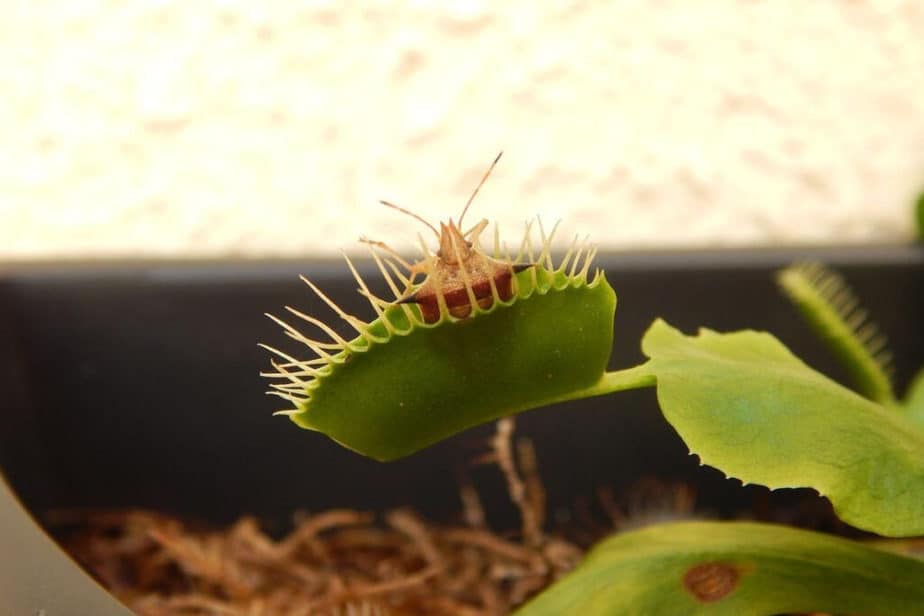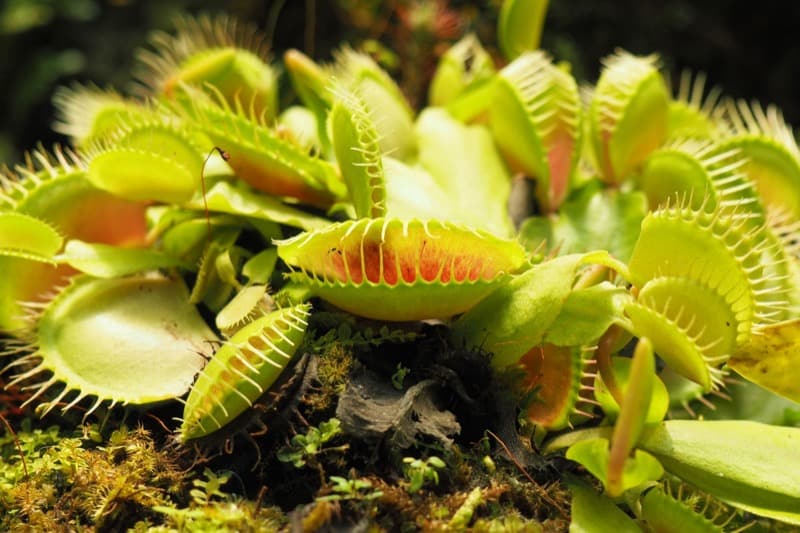The Giant Venus flytrap B52 is well-known for its huge traps that will grow larger than 2 inches long.
In this care guide, we’ll cover everything you need to know about caring for the giant Venus flytrap to grow the large traps. We’ll go over the history of the plant, its growth habits, and how to care for it properly.
- Related article: Venus Flytrap Care
The Giant Venus Flytrap B52 Overview
The B52 Giant Venus Flytrap is a unique Dionaea muscipula cultivar in the world of Flytrap cultivation. The standard Venus Flytrap is perhaps the most well-known of these plants, but many cultivars have been developed by scientists, botanists, and Venus Flytrap enthusiasts, each with its own individual and defining characteristics.
Venus Flytrap cultivars do not appear in the wild naturally, but are developed through human intervention in specific controlled environmental conditions.
Among these cultivars, the B52 has a special place for its size, as it is considered a giant Venus Flytrap. This clone was produced in the United States by Henning Von Schmeling.
The name “B52” is not related to the famous bomber jet used in WWII, but was merely the code given by Schmeling to the plant he was cultivating.
The name, however, is fitting as the B52 is large. It grows in clumps, making it not only impressive for its vigor, but in appearance as well.
B52 Venus Flytrap Size Comparison
Standard Venus Flytraps will grow traps that measure approximately an inch in size. The entire Venus Flytrap plant generally measures 5 inches in diameter, and more or less a foot in height.
How big do Venus Fly trap get? The B52 Venus Fly Trap clone features traps that can grow more than 2 inches in length or twice the size of a standard Venus Flytrap size.
The standard Venus Flytrap will have no difficulty capturing and digesting prey that is approximately a half-inch in length or half the size of its trap. The B-52 becomes quite impressive in this sense because it has a much larger capacity when it comes to capturing prey.
- Related article: How Big Do Venus Flytraps Grow?
All Venus Flytraps will capture flies, spiders, and similar, but these plants theoretically are not obligated to only eat insects as they are carnivorous. They can eat some protein of almost any type, as long as the trap can close around the prey.
With much larger traps, the Dionaea B52 clone will have more capability to capture and digest tiny frogs, birds, and rodents. Something that standard Venus flytraps will generally not be able to do.
The principal differences between the B52 and other cultivars are the size of the traps, which are double the size, and the characteristically short leaf base that they exhibit.

B52 Venus Flytrap Care Guide
Despite the B52 being a cultivar that is a variation of the standard trap, general care for these plants is pretty basic. Follow these steps for B52 Venus fly trap care and you’ll be good to go with this giant Venus fly trap variety.
Soil and Growing Medium
Ideally, you should select a nutrient-free carnivorous plant soil mix that’s well-draining. If your gardening center does not have a specific carnivorous plant soil mix, you can usually find them online.
You can mix your own soil using a blend of peat moss or long-fiber sphagnum moss with perlite or silicas sand in a 4:1 or 2:1 ratio.
Do not use succulent or cactus soil. And never use any soil mix that contains fertilizer or organic compost.
- Learn more about Venus Flytrap Soil Mixes.
Light
A B-52 Flytrap will require lots of sunlight as part of its daily regimen. These plants obtain most of the nourishment necessary to survive through photosynthesis.
If they do not receive adequate light, they will not be able to photosynthesize, so will weaken and eventually die. 8 to 12 hours daily of bright light is optimal, but you should guarantee a minimum of 4 hours.
If your home does not have access to bright indoor light, a grow light can be used to supplement nutritional needs.
The B52 clone boasts a bright red hue inside its traps. The red will remain vibrant as long as the trap gets sufficient light. Should it begin to fade, you’ll know there is insufficient lighting.
Read more about Venus Flytrap Lighting Requirements.
Water and Humidity
A B52 Venus Flytrap will require water often as the soil bed needs to remain moist at all times. The growing medium should not be allowed to dry out.
Water quality is of the utmost importance, as common tap water should never be used. Because Venus Flytraps grow in nutrient-poor soil in their native habitats in the coastal states of North and South Carolina, these conditions need to be replicated.
Water with chemicals or minerals can be lethal to these plants. When watering, only use distilled water, rainwater, or reverse osmosis water.
The Venus Flytrap B52 prefers humidity levels above 50%, similar to those of the wetlands of its native habitat.
Learn more: How Do You Water a Venus Fly Trap Plant.
Temperature
The ideal temperature range for your Venus Flytrap B52 is between 70° and 95° Fahrenheit.
Extreme heat may weaken the plant and excessive light can burn leaves, causing red sots at the leaf base to form.
During winter dormancy, a Venus Flytrap B52 cultivar should enjoy a temperature that sits between 32° and 45°F. Higher temperatures may interfere with the necessary dormancy period, causing the plant to weaken.
Learn more about the Dormancy for Venus Flytraps.
Feeding Insects and Fertilizer Use
Your B52 will appreciate consuming an insect every 2 to 4 weeks. Only one trap should be fed as that is enough to nourish the entire plant. These plants do not require daily feeding and fertilizer should not be used.
When feeding a bug to your B52, make sure that the insect is no larger than one-third to half the size of the trap. This allows the trap to close completely on the bug and digest it without difficulty.
Never give your B52 human food of any kind. These plants consume mainly insects, and the occasional rodent, bird, or tiny frog, size permitting. If you have an insect or worm that is too large, cut it into pieces before offering it to your plant.
Plant fertilizer will kill the B-52 giant Venus flytrap too, soi it’s best to avoid feeding it extra plant food.

Pruning
As part of the natural life of the B52, traps will occasionally wither and die, leaving space for new trap growth to sprout. Once the trap has died, it will turn black, and you can prune away these dead leaves gently.
Never pull off dead leaves. Always trim them off with sterile pruning shears or scissors. Pruning must be done in a very delicate manner to avoid triggering the other live traps and wasting the plant’s energy.
B52 Venus Flytrap Care Final Thoughts
If the size of the B52 Venus fly trap is what captivates you the most, know that while the traps are larger than those of a standard Venus Flytrap, the B52 is not the largest cultivar.
Consider the Dionaea Ginormous variety, which boasts even larger traps!
Here are other Venus Flytrap articles to learn more:



